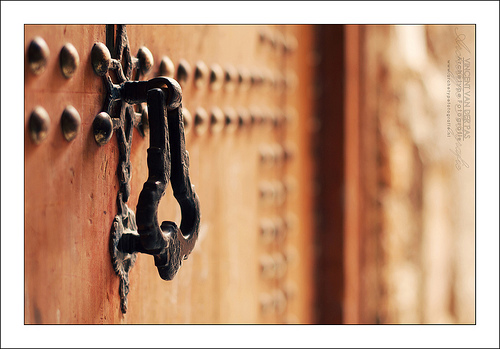
Someone knocks at your door. They want to convert you to their faith. What is the crucial issue? What about someone who doesn’t knock, on the premise that all kinds of beliefs are okay. What is at stake?
They might want to talk about Jesus. They probably claim the name Christian.
One crucial underlying question as ordinary Christians encounter modern variations on the theme is this:
“Who is the God you worship?”
The Heidelberg Catechism (I’ve been blogging on this beloved Reformed text in honor of its 450th anniversary — see the posts here) orients its readers to this question in its large central section where, line by line, it explains the “Apostles’ Creed.”
Question 24 observes that the Creed is divided into three sections:
God the Father and our creation;
God the Son and our deliverance;
and God the Holy Spirit and our sanctification.
If you could probe the issue with the person on your doorstep you would find Heidelberg is speaking a difference language. You might find common ground in the things the Catechism says God does: God creates, delivers, and brings us toward holiness.
But you would find a contrast, subtle or plain, in the Catechism’s claim that the Father is God, the Son is God and the Spirit is God.
Your visitor might accuse you of believing in three Gods instead of the One God. Heidelberg’s next question takes that one head on.
25. Q. Since there is only one divine being, why do you speak of three: Father, Son, and Holy Spirit?
The terse answer expresses views that evolved in the earliest centuries and was firmly declared in the Ecumenical Councils:
A. Because that is how God has revealed himself in his Word;
these three distinct persons
are one, true, eternal God.
The Catechism is saying two things:
- Christians believe about God what God has chosen to show us in the Bible.
- The God revealed in the Bible is what the Church came to call the “Trinity.” This God is eternally one God but, mysteriously, eternally three distinct persons.
The first point is straightforward: we learn of God in the Bible, not from unaided reason or someone’s new revelation — and some tried to go those routes in the 16th century just as groups do today.
On the second point your visitor might say you and your Catechism are on shakier ground — especially since the Bible doesn’t use the word “Trinity.”
Actually, Heidelberg doesn’t use it either. Heidelberg simply describes the Trinity in terse classical terms. One eternal God, three distinct persons, Father Son and Holy Spirit, each eternally God.
Heidelberg is still content to assert this is the Bible’s teaching. In case you want to look up the texts it cites Deuteronomy 6:4, Isaiah 61:1, Psalm 110:1, Matthew 3:16-17, Matthew 28:19 and 1 John 5:7[-8].
It is an interesting group of texts.
Only Matthew 28:19 lists the three persons by name — but it is an important text, since Jesus says you must Baptize in the name of these three. (If you happen to be using the King James, 1 John 5:7-8 does so too — the best manuscripts available in Heidelberg’s day included words most translations would now omit.)
The others show a kind of plurality in God, a conversation even, as at Jesus’ Baptism where the Spirit descends and the Father speaks.
For four centuries Christians wrestled with these and other biblical references, with the Church’s liturgical language, and with the implications of alternate views. Heidelberg simply agrees with the great Councils of Nicaea I (325) and Constantinople I (381) that this understanding of who God is distinguishes Christians from others: God is eternally One God, and eternally three Persons, Father Son and Holy Spirit.
This is the God we worship and love with all our hearts, all our souls, all our minds, and all our strength.
What alternate views of the Trinity have you run across in your life and ministry?
What has proved to be important to you in your understanding of the Trinity?
____________
If you like the post I hope you’ll share it! You can use the buttons below.
And if we aren’t connected yet on Facebook I hope you’ll “like” my page.

In a recent bible study we talked about the Trinity and the instructor used a good example that I’d like to share (wish I could add pictures like you do). Imagine a large circle with a mid size circle inside of it and a small circle inside the mid size circle. The large circle is the body (Jesus Christ), representing the outside world of our lives and things we experience, the mid size circle is the (Soul), representing imagination, memory, desires, consciousness, and the small inner circle is the (Spirit), representing incommunicable characteristics of God, faith, hope, reverence. I found this analogy to be helpful in my study and learning of the Trinity.